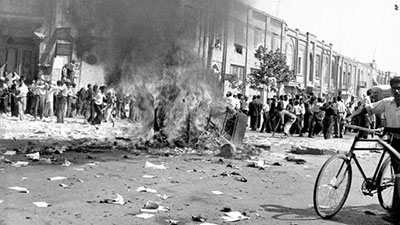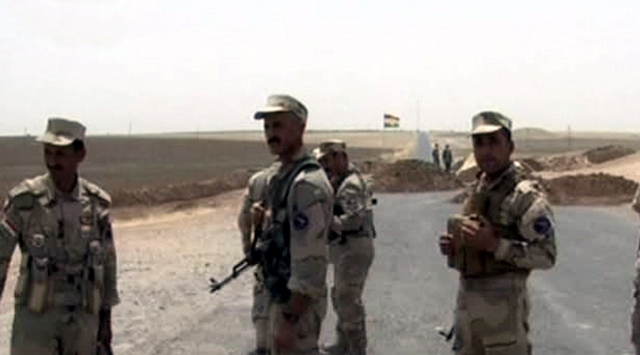Roji Kurd: In mid-August, without sufficient preparations and regardless of army’s advice, the Revolutionary Guard marched on the Kurd-held town of Paveh, falling into a major ambush. The defeat prompted Khomeini to approach the heads of the army and the government. The new Iranian Islamic leadership had little patience for Kurdish requests and opted for crushing unrest through military means. As a result, Khomeini, the new religious leader of Iran, declared a jihad (holy struggle) and a fatwa (religious edict) against the Iranian Kurds and key Kurdish nationalist figures were declared “enemies of the state”, like Ghassemlou, in his statement on August 17, 1979 The government then began a three-week campaign to clear out Kurdish strongholds, mainly Saqqez and Mahabad.
On August 20, 1979, the Iranian army started the Siege of Mahabad. By August 30 it was reported they had managed to completely surround the city and three days of negotiations started. After this failed, Iranian forces invaded the city on September 3 backed by F-4 fighter jets and over 100 tanks. Backed also by artillery power, they managed to seize control of the town after just several hours of fighting. The defeat in Mahabad was a major blow to the Iranian Kurds, and afterwards Iranian forces continued to march on the smaller town of Baneh. Over 500 people were killed during the siege.
The defenders were overwhelmed by the power of the Iranian offensive, using heavy artillery, tanks and air cover, but managed effective resistance. Despite the heavy casualties, the bulk of Kurdish Peshmerga evaded capture and death, so they retreated into the mountains. The Kurds resumed their offensive six weeks later, returning to Mahabad and effectively fighting the armor forces of Iran with Molotov cocktails and RPGs. In the end of November, Kurds also attacked Sanandaj, Saqqez and other Kurdish cities and towns. Kurdish effective initiative continued, as Iranian government was distracted by other events in the country, such as the American Embassy hostage crisis in Tehran.
In a speech on 17 December 1979, Khomeini called the concept of ethnic minority contrary to Islamic doctrines. He also accused those who do not wish Muslim countries to be united in creating the issue of nationalism among minorities. His views were shared by many in the clerical leadership.
The new Iranian administration of President Banisadr took office. In late January 1980, Revolutionary Guard units and government supporting Kurds unsuccessfully battled rebels in the region, resulting in a stalemate that lasted until spring. By May 1980, Kurds still controlled much of the regions’ roads, rural areas and holding once again the city of Mahabad as their capital. The KDPI said that they control over 7,000 fighters at the time.
The fatwa, dated August 18, read in full:
In the name of god, the compassionate the merciful,Requests have been made on behalf of different groups in the armed forces and the Pasdaran and honorable people for me to order [the forces] to go towards Paveh and end the clashes. I thank them and warn the government, the armed forces and the Police that, if within the next 24 hours, a move towards Paveh is not made with canons, tanks, and equipped forces, I consider all responsible.
As the head of the armed forces, I order the head of the army headquarter to dispatch to the region immediately, fully equipped, and I order all the bases of the military and Police to not waste time and not wait for another order and dispatch to Paveh with full equipments. I order the government to immediately provide for the dispatching of the pasdaran. Until further notice, I consider the armed forces responsible for this violent killing and if they disobey my order I will deal with them in a revolutionary manner. Repeated messages from the region say that the government and the armed forced are not taking any actions so [I announce] that if a positive action does not take place within the next 24 hours I will hold the heads of the military and police responsible.
Autumn 1980 Iranian operations
In late August 1980, Iranian army failed to sack Mahabad, held by the Kurds for ten months. They continued to hold it for five more months, as the Province of Kordistan became the theater of the Iran–Iraq War. Although President Banisadr ordered a cease-fire with the Kurds, following the Iraqi invasion, the Pasdaran ignored him, continuing their campaigns.The confrontation between Tehran and the Kurds intensified sharply when the Iran–Iraq War broke out, as Iran faced Iraqi support to the Kurdish insurgency in Iran, while waging its own campaign to encourage risings of various groups within Iraq. It was initially assumed that Iraqi Kurds and their Iranian brothers would cooperate to exploit weaknesses on both sides. Not surprisingly, neither Baghdad nor Tehran was willing to accept that outcome. Rather, both sides insisted on organizing special loyalist Kurdish military units to participate in the war and to demonstrate allegiance to their respective states. Essentially, the Iraqi KDP and the KDPI were split, experiencing a series of internal conflicts.The Pasdaran units had not been effective against the Kurds, until Revolutionary Guard backed units engaged into fighting with Iraqis and Iraqi-backed Kurds in late December.
1979 Kurdish rebellion in Iran
The 1979 Kurdish rebellion in Iran erupted in mid-March 1979, some two months after the completion of the Iranian Revolution, and became the largest among the nationwide uprisings in Iran against the new state and one of the most intense Kurdish rebellions in modern Iran. Initially, Kurdish movements were trying to align with the new government of Iran, seeking to emphasize their Muslim identity and seek common ground with other Iranians. KDPI even briefly branded itself as non-“separatist” organization, allegedly criticizing those calling for independence, but nevertheless calling for political autonomy. However, relations between some Kurdish organizations and the Iranian government quickly deteriorated, and though Shi’a Kurds and some tribal leaders turned towards the new Shi’a Islamic State, Sunni Kurdish leftists continued the nationalist project in their enclave in Kurdistan Province.While at first, Kurdish militants, primarily of the Democratic Party of Iranian Kurdistan, made some territorial gains in the area of Mahabad and ousted the Iranian troops from the region, a large scale offensive in spring 1980 by the Iranian Revolutionary Guard reversed the course of the conflict.Following the eruption of the Iran–Iraq War in September 1980, an even greater effort was made by the Iranian government to crush the Kurdish rebellion, which was the only one of the 1979 uprisings to still go on (Arab, Baluchi, and Turkmen rebellions had already been subdued by that time). By late 1980, the Iranian regular forces and the Revolutionary Guard ousted the Kurdish militants from their strongholds, but groups of Kurdish militants kept executing sporadic attacks against Iranian militias. The clashes in the area went on as late as 1983.About 10,000 people were killed in the course of the Kurdish rebellion, with 1,200 of them being Kurdish political prisoners, executed in the last phases of the rebellion, mostly by the Iranian government. The Kurdish-Iranian dispute resurged only in 1989, following the assassination of a KDP-I leader.
By; BahoziKurdistan



























































